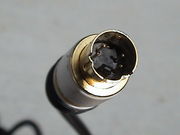Difference between revisions of "Console Recording"
From SDA Knowledge Base
(→Composite) |
|||
| Line 10: | Line 10: | ||
===Composite=== | ===Composite=== | ||
| − | [[Image:Composite.jpg|frame|right|The "out" end of a composite cable.]] | + | [[Image:Composite.jpg|frame|right|The "out" end of a composite cable (yellow cable).]] |
A composite cable ends in three colored plugs - a yellow one, a red one, and a white one. These are plugged into three color coded ports on the back of your VCR or DVD recorder. The yellow plug carries the video signal, while the red and white plugs carry the left and right audio signals. | A composite cable ends in three colored plugs - a yellow one, a red one, and a white one. These are plugged into three color coded ports on the back of your VCR or DVD recorder. The yellow plug carries the video signal, while the red and white plugs carry the left and right audio signals. | ||
Revision as of 13:26, 5 September 2006
Capturing a console run is basically like taping a normal television show. However, SDA has higher standards for run quality than some guy making sure he doesn't miss the latest episode of Surivior. In order to make sure your video quality is the best it can be, it's important to be careful.
Video Cables
The first step in the video's journey from console to our servers is the audio out cable. There are generally two cables you plug into your console; the power cord, and the audio out cable. There are three different kinds of audio out cables that consoles can use, and choosing the best one can have a dramatic effect on your video quality. In order, from worst to best, they are:
RF
An RF cable ends in a box with a cord sticking out. You plug the cord sticking out into the back of your TV, where you would normally plug in your cable TV hookup. To continue watching cable TV, you would also plug the cable TV hookup into the box. Games are displayed in place of channel 3 or 4 whenever the console is turned on.
RF is an ancient, ancient technology. It is pretty much worthless, and will shoot your run quality to hell. Do not use it if at all possible. The only system I know of that does not support composite cables is the rare "NES II". (The NES II is a late-model redesign released in the final days of the NES and is easily identifiable by its top-loading cartridge slot and SNES-style controllers.)
Composite
A composite cable ends in three colored plugs - a yellow one, a red one, and a white one. These are plugged into three color coded ports on the back of your VCR or DVD recorder. The yellow plug carries the video signal, while the red and white plugs carry the left and right audio signals.
While not nearly as horrible as RF, composite video is still fairly lame next to S-Video. However, since S-Video is a newer technology, not all earlier consoles support it. The Gamecube, PS2, XBOX, and Dreamcast all support S-Video, as will all consoles newer than those. In addition, thanks to the fact that Nintendo has used the same AV port for a decade now, the SNES and Nintendo 64 can use S-Video cables designed for the Gamecube. PS One and Playstation 2 S-Video cables are compatible with each other as well. The Sega Saturn also has support for S-Video. Older consoles do NOT have S-Video cables; therefore, composite cables offer the best quality avaiable for these systems.
Also, older VCRs may not support S-Video either, although S-Video cables are backwards compatable on the recieving end, as described below. Still, you won't get S-Video quality unless you have a true S-Video port.
S-Video
The S-Video cable looks very much like a composite cable. However, in addition to the three colored plugs, there is also one, much larger metal plug. This plug is the S-Video plug, which carries the best video signal available. The audio is still transmitted over the red and white cables.
Note that BOTH the yellow plug and S-Video plug carry the video signal. Only the S-Video plug carries the superior quality signal; the yellow plug carries a composite signal so that the cable can work with older TVs. If both are plugged in, the S-Video signal will be shown. (It's quite instructive to plug all of them in, and then take out and put in the S-Video plug. It's a side by side comparison!) Note that, depending on how your cable is made, you might be able to plug the S-Video and composite cables into two different appliances and have both recieve a signal.
Recording Medium
There are two mediums you can record to: VHS and DVD. DVD is far superior to VHS, but costs more at this time. While it's recommened that you shell out the extra cash if you can, VHS runs are still accepted for the moment. For a more detailed discussion and the next steps for you to take, read the VHS and DVD sections.

